The purpose of clinical screening of healthy ageing dogs and cats is to detect any subclinical abnormalities at a time when preventative and therapeutic intervention may be most beneficial and to establish a baseline assessment for future comparison (American Animal Hospital Association (AAHA), 2005). The AAHA (2005) estimates that only 14% of senior companion animals undergo regular health screening as recommended by their veterinary surgeon or veterinary nurse, citing the main obstacle to client compliance as the lack of a clear recommendation by the veterinary practice team. Extensive planning of nurse-led senior clinics is therefore essential and an approach to the assessment of the senior patient should be discussed and wherever possible standardised amongst all members of the practice team.
How will the senior patient be assessed?
Assessment of the senior patient may take a number of forms including:
Comprehensive history taking and owner questionnaire
Before examining the animal, it is essential to take a detailed patient history. Owners are in a unique position to note subtle changes in daily routine, but may not offer such information unless prompted. Clients often feel rushed or under pressure when asked questions regarding their pet within the ‘clinical’ environment. Allowing clients the time to consider their pet's behaviour while they are relaxed will generally yield more comprehensive results. In order to facilitate this, a questionnaire can be sent ahead of time with the client asked to either return it prior to attending the clinic or bring it with them to their appointment.
The results of the questionnaire can be discussed with the client during the clinic, and used as a means of directing specific questioning during the history taking and possibly as an aid to diagnostic testing.
Another advantage of taking a thorough history is that it gives the animal a chance to acclimatise to being at the practice. Dogs should be let off leads and cats allowed to come out of the basket to explore the consulting room.
After taking the history, the veterinary nurse should take a few minutes to introduce themselves to the animal. It is important to remember that ageing animals are less adaptable to stressful situations and some will have compromised sight or hearing which can compound the situation.
Systematic health check
The veterinary nurse should be adept in the performance of the physical examination, although the veterinary surgeon may elect to perform this procedure.
The physical examination should become a routine for the veterinary nurse, with examinations carried out in the same manner every time wherever possible, for example, head to tail or by body system, helping to minimise the possibility of forgetting to check a vital system. Remember it is thorough history taking and clinical examination that will likely reveal the painful tooth or the overgrown dew claw — not any amount of sophisticated diagnostic testing. It is important to talk to the client during the examination and engage them in the process; this provides a valuable opportunity to educate and promote active health care.
Areas to focus on during a senior health check
Areas to focus on during a senior health check include: eyes; ears; mouth; neck; thorax; abdomen; the rectum and genitalia; body condition; and limbs.
Eyes
The animal's eyesight can be checked by taking a small piece of cotton wool and dropping it from a height in view of the animal; most animals will generally catch sight of this and briefly watch it as it falls. Cats, however, are very good at ‘selectively’ not following the cotton wool so this must be taken into account. The menace response can be tested by holding the patient's head with one hand and using the other hand to quickly move towards the eye, this will confirm if the animal can see objects coming towards it as it will blink in response. Care should be taken not to make over exaggerated movements as these may startle the patient. Finally objects can be placed onto the floor and the animal encouraged to manoeuvre around the room to see if it can navigate around them.
Ophthalmic problems increase in frequency with age and a number of common age-related systemic diseases such as renal failure, hyperthyroidism and diabetes mellitus, may cause retinal abnormalities, most notably vascular changes associated with hypertension (Davies et al, 2015). Mould (1993) stated that direct ophthalmoscopy was the method of choice for retinal examination in first opinion veterinary practice. While an experienced veterinary nurse may be proficient at this skill, a veterinary surgeon may elect to perform this procedure.
Ears
A loud clap should be made away from the animal. The animal should react to the sound by twitching their ears or turning their head in the direction of the sound. The external ear pinna should be examined for signs of inflammation or discharge and the ear canal examined with an otoscope.
Mouth
Dental disease is extremely common in the ageing patient and is a frequent cause of anorexia (Figure 1). The mouth should be examined for evidence of gingivitis, periodontitis, fractures, hyperplasia, epulids and any sign of oral masses. Veterinary dental treatment may be advised and home dental prophylaxis can be demonstrated if necessary.
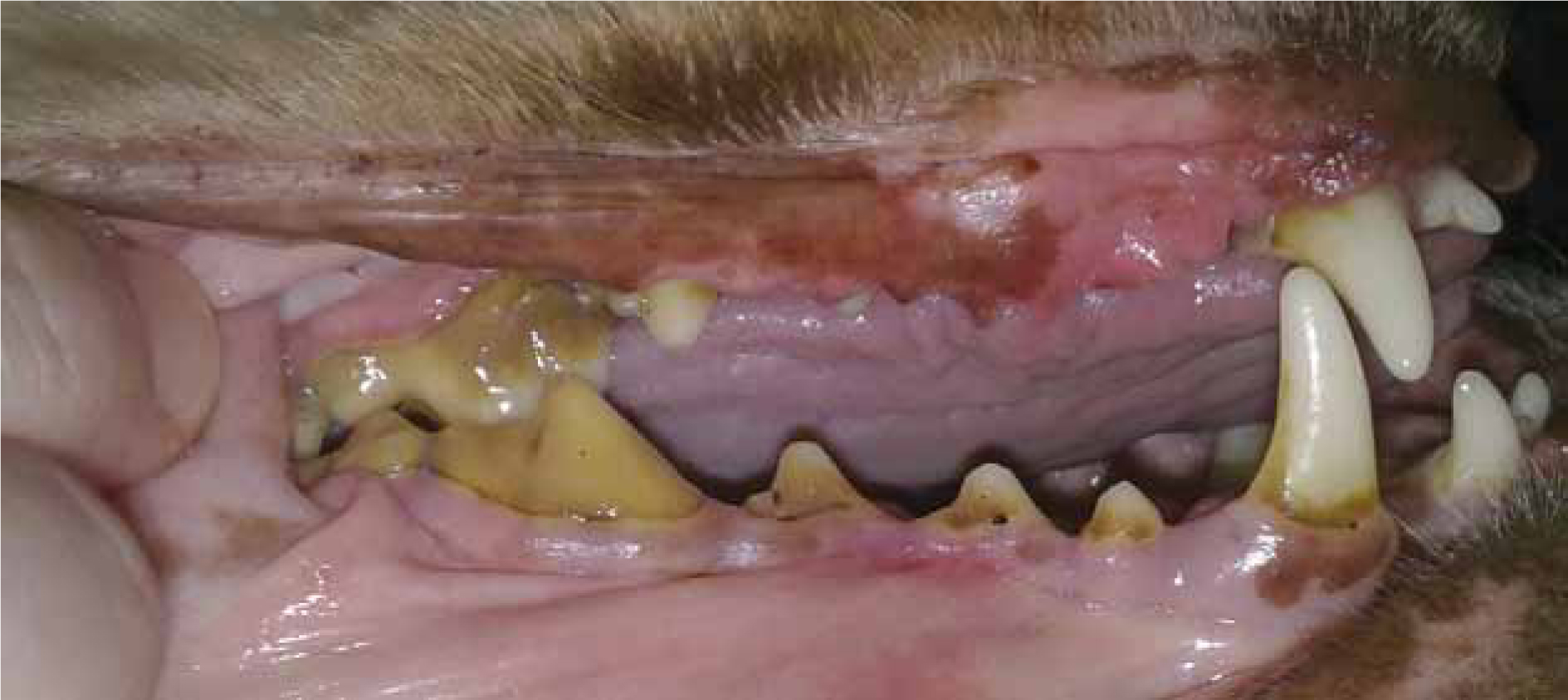
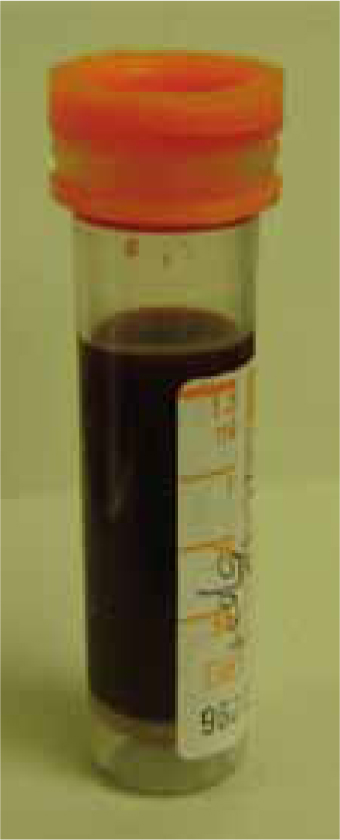
Neck
The hands should be run down the neck to check for abnormal lymph and thyroid glands and over the shoulders to check for muscle wastage.
Thorax
The hands should be run over the thorax to feel for any abnormalities including masses; obese dogs commonly develop lipomas, particularly over the cranial thorax, however masses must not be assumed as benign. A fine needle aspirate and cytology will likely be required; this will be determined by the veterinary surgeon. The heart should be auscultated on the right and left side of the thorax using a stethoscope. The cardiovascular system should be assessed via the heart rate, rhythm, presence of a murmur or a pulse deficit which can be ascertained by auscultating the chest and taking the pulse rate simultaneously. The lungs should be auscultated for any evidence of respiratory noise and the respiratory rate should be noted.
Abdomen
Abdominal palpation is a definite skill which should be practised on as many healthy animals as possible in order to try to familiarise oneself with what feels normal, in particular the size and shape of the liver and kidneys. Young animals admitted for routine neutering provide the ideal candidates for this. Along with palpation, the skin and fur should be checked for general health including any evidence of thinning or alopecia, ectoparasites and cutaneous and subcutaneous masses.
The rectum and genitalia
The rectum and gentitalia should be checked for abnormalities including the presence of faeces or abnormal discharge. It should be noted if the animal is entire or neutered. If entire, the owner should be informed of the potential age-related diseases, such as pyometra, mammary or testicular neoplasia or prostatic disease and informed of the clinical signs to look out for.
Body condition
An accurate weight should be measured and any changes discussed with the client and compared with previous records. Any changes in body condition or conformation should also be noted. Checking the weight and body condition of the animal presents an ideal opportunity to discuss dietary matters with the client, including the importance of senior nutrition, or the significance of a weight reduction diet if relevant. All palpable lymph nodes should be checked for any sign of enlargement.
Limbs
All limbs should be examined and checked for any evidence of swelling or discomfort, which may be due to the presence of osteoarthritis. Within the musculoskeletal system many physical changes become apparent as time passes, a number of which can be profound. The slowly progressive symptoms of osteoarthritis are commonly misinterpreted by dog owners, as they assume that the ‘slowing down’, or reluctance to jump onto the sofa or into the car, is due to an age-related decline in energy, rather than an age-related disease. Osteoarthritis is the term given to a progressive, irreversible joint disease associated with cartilage degeneration, modification of sub chondral bone, development of osteophytes, synovitis and fibrosis of the joint capsule (Millis et al, 2004).
The limbs should be gently flexed and extended, however this must be stopped once resistance is felt. The owner should be asked to gently walk the animal towards and away from the veterinary nurse in order to examine its gait. Remember to also examine the claws carefully as these often become brittle and have a tendency to overgrow in the ageing animal.
Any abnormalities found during the clinical examination should be brought to the attention of the veterinary surgeon; remember it is the veterinary surgeon who will make a diagnosis.
Diagnostic testing
While it would doubtless be beneficial to run all of the diagnostic tests available, this would not be practical or affordable for most clients. Metzger (2005) and Fortney (2012) suggested a reasonable starting minimum database for the ‘healthy’ older dog should include a complete blood count, biochemical profile with electrolytes, urinalysis including specific gravity, urine dipstick, and possible cytology, with a total thyroxine test and testing for feline leukaemia and immunodeficiency viruses also advocated in the ageing feline patient.
Brown et al (2007) recommended the addition of systolic blood pressure measurement to the minimum senior database for all amenable ageing dogs and cats (Figure 3). There is, however, much disparity surrounding what constitutes a minimum laboratory and diagnostic database. Consideration and discussion between team members must therefore take place regarding the range of testing to be undertaken; it is much easier to add a test and expand the range of testing than to remove a test because the cost was considered too excessive for the average client. If cost is a concern for the client, a minimum senior work up could consist of a urine dipstick, urine specific gravity and blood pressure measurement if the pet appears otherwise healthy (Wakeling, 2009) (Figure 4).
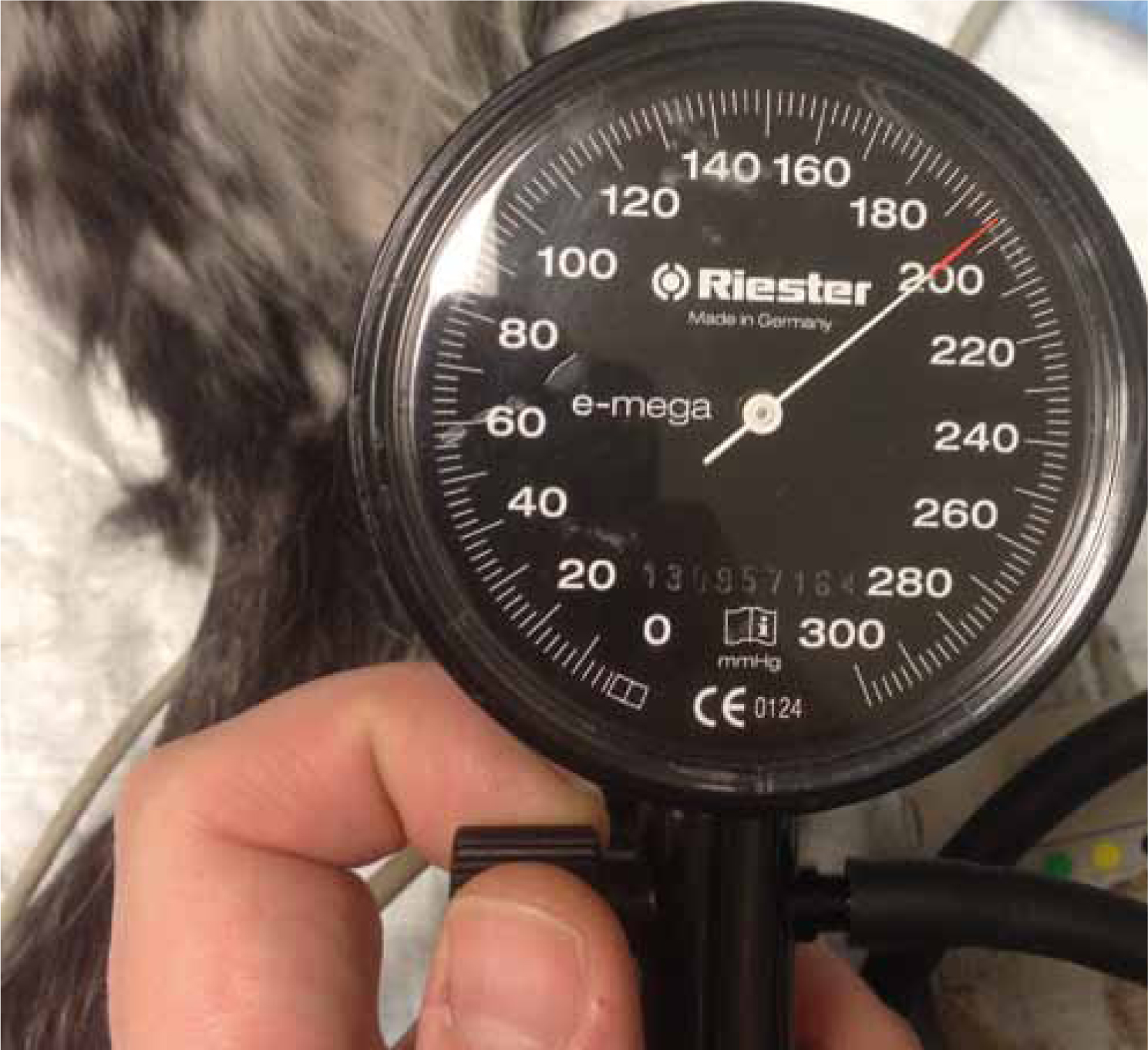
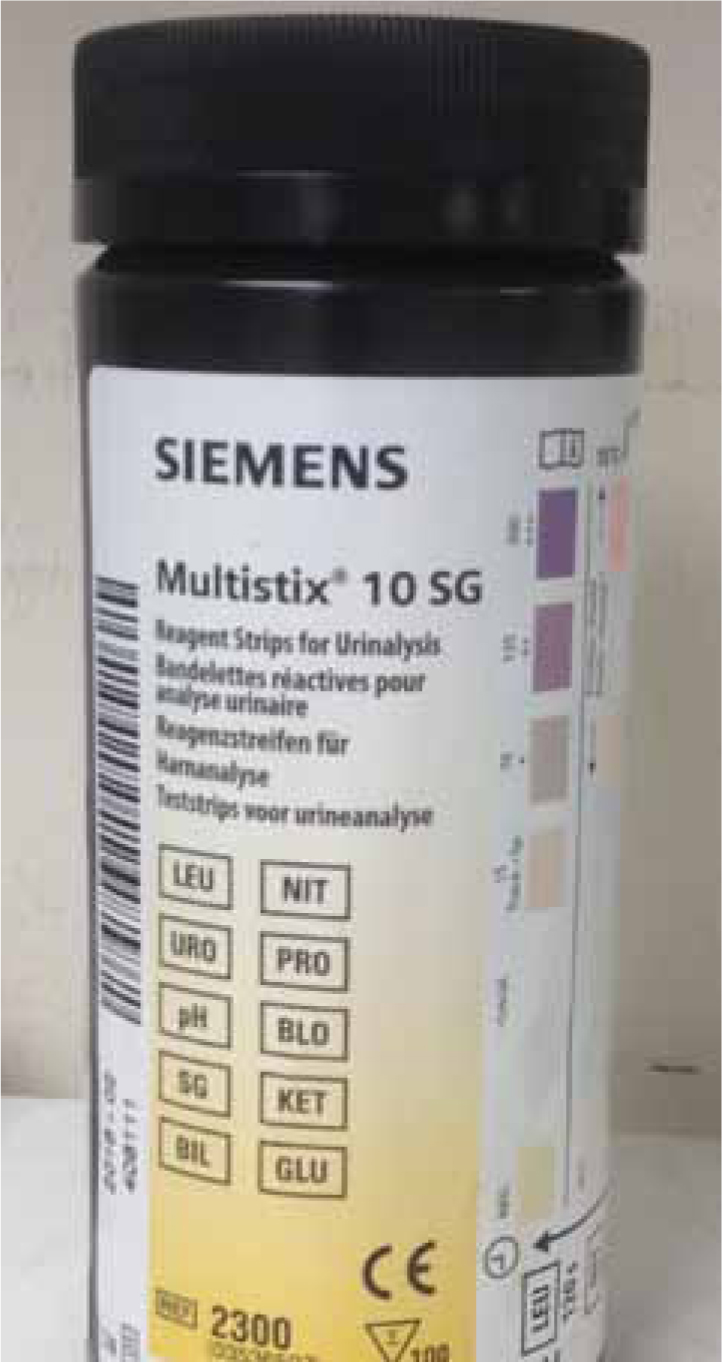
Additional diagnostic testing may include an electrocardiogram, especially for breeds susceptible to cardiomyopathy, and thoracic and abdominal imaging by means of either radiography or ultrasound may be used to screen for occult neoplasia, organomegaly or to check for signs of arthritic change (Figure 5). Additional testing should be guided by the results of the clinical examination and results of the minimum database and will be determined by the attending veterinary surgeon.
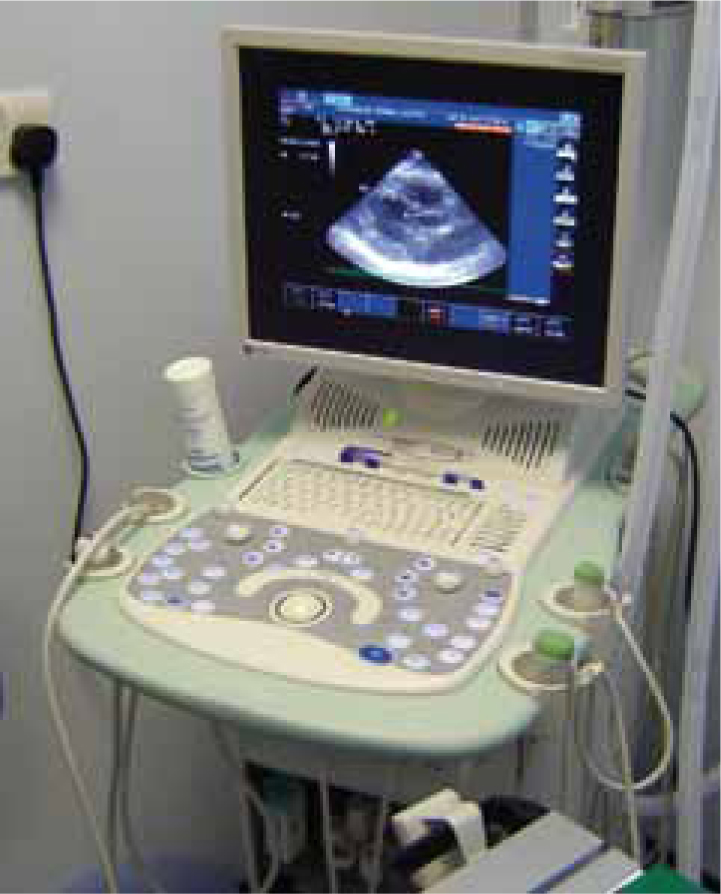
Focused areas of client education
Preventative care is directed at making recommendations prior to the onset of disease wherever possible in order to prevent or reduce the effects of disease or adverse health conditions. The nurse-led senior clinic provides a valuable opportunity to actively engage the owner in the health care of their ageing companion; they are in a unique position to notice subtle changes in their pet's habits, activity level or behaviour, however they must be educated regarding what signs to actively look out for. Veterinary nurses have a pivotal role to play in encouraging owners to be vigilant regarding changes in their ageing companion and reporting these to the practice staff sooner rather than later. By combining education with some specific training, most owners can become an important member of their pet's healthcare team.
Frequency of examination
The American Association of Feline Practitioners (2008) advocate the examination of healthy senior cats every 6 months, and Wakeling (2009) suggested this could be extrapolated to dogs also. Taking the time to explain to clients that 6 months in the life of their ageing pet may be compared with 2 to 3 years of their own life, may help to facilitate client compliance with regards to attendance.
Reflection
Practice meetings and client feedback should be used to review how the clinic is progressing. The objectives for the clinic should be revisited; are these being achieved, if not, why is this?
A successful clinic will be one that is regularly reviewed and revised to ensure that it is meeting the needs of all parties concerned.
Conclusion
The willingness of clients to participate in a comprehensive senior healthcare programme rests on the veterinary team's ability to educate clients surrounding the importance of senior wellness checks and the value of early screening for age-related disease.
Veterinary nurses are key in this education process and running nurse-led senior clinics provides the opportunity to not only improve the welfare of ageing dogs and cats but to improve one's own level of knowledge, skills and ultimately job satisfaction. The passing of the new Royal Charter and the continuing work by the Royal College of Veterinary Surgeons (RCVS) and the RCVS Veterinary Nurses Council, amongst others, to protect the title of veterinary nurse in the UK means there has never been a more pertinent time to show the general public and fellow veterinary colleagues, the knowledge and skills that qualified veterinary nurses possess; the future is bright — the future is veterinary nursing!

